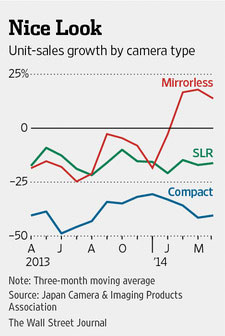The Wall Street Journal blames Nikon’s poor overall performance on missing the mirrorless boat. “Nikon needs to start breaking some mirrors,” the paper says. “That isn’t usually seen as a way to good fortune, but mirrors — specifically, the ones that add bulk to its high-end SLR cameras — are one of Nikon’s biggest problems right now.”
Up to a certain point mirrorless cameras today deliver what DSLRs do. Let’s not descent into pseudo-religious talk by saying one system is better and one is poorer. To each his or her own. The end justifies the means, so as a photographer you alone should and can know what system suits you best. Mirrorless today is up to the most demanding jobs — something Nikon still seems to ignore, says the Journal, and one wonders why they don’t mention Canon.

Both Canon and nikon offer mirrorless “compromises,” fearing that releasing a full-blown mirrorless camera systems would cannibalize their high-end DSLRs. Quoting form the Journal:
The digital-camera market is in sharp decline as smartphones spread. Compact cameras have been hit hardest, but Nikon’s professional grade cameras are suffering as well. Just one category shows growth: “mirrorless” cameras. They are smaller and cheaper than DSLRs but also offer high image quality and interchangeable lenses. They make for a good upgrade from a smartphone camera without breaking the bank.
In the first four months of 2014, shipments of mirrorless cameras by Japanese firms rose by 12% year over year, according to the Camera and Imaging Products Association (CIPA). Shipments fell 42% for compact cameras and 17% for DSLRs.
Nikon was the last of the major Japanese makers to release a mirrorless camera. It likely fears cannibalizing its high-end DSLRs, but its strategy seems not to be working. Revenue for its camera division fell 9% in the year through March. Sony, Olympus and Panasonic are leading in the new field.
Nikon’s solution to its flagging stock price seems rash. Incoming Chief Executive Kazuo Ushida said Nikon plans to dive into medical equipment, where it has no expertise, and has earmarked $2 billion for relevant acquisitions.
Canon invests heavily in security cameras, Nikon’s sees the future in medical equipment. Both may have missed the party. And rival Olympus is already a leader in medical imaging as well as in mirrorless cameras…
The solution to Nikon’s problems is easy, concludes the Journal. To revive its image among investors, it must focus on making cameras that consumers actually want to buy.
Which raises the question whether Nikon — or Canon for that — are willing to drop their halfhearted mirrorless systems to come up with something more substantial that’s on par with DSLR performance. I got nice results with the Canon M, yet (and pardon my French) the smaller the sensor, the flatter the images seem…
Micro Four Thirds reaches a sweet spot already, delivering high image quality. However, at the latest since the ascent of the Sony A7 lineup the benchmark is, again, 35mm. Dropping one young small-sensored mirrorless system — or developing two mirrorless systems simultaneously — would be any camera company’s nightmare.
Either way, both Nikon and Canon have to act (while I remain a completely happy user of that old box with mirror technology while shooting mirrorless alongside…).


